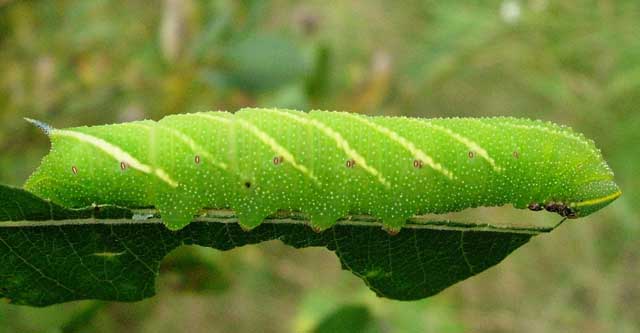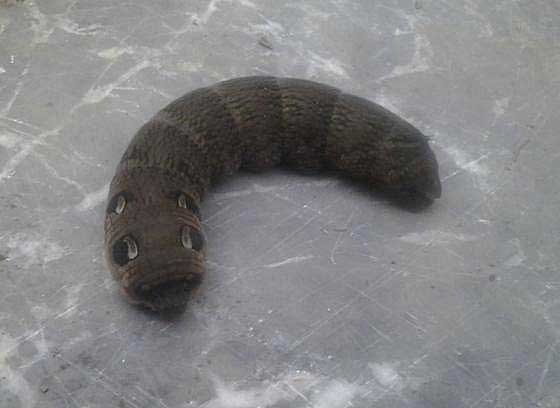Sphinginae subfamily
Sphingini tribe:
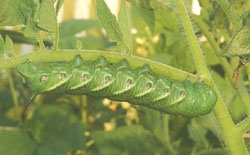
|
The caterpillars are called Tomato Hornworms and each has a black horn at the end of the abdomen.
Larvae feed on potato, tobacco, tomato, and other plants in the
nightshade family (Solanaceae). There is also a very beautiful brown
form. See species file.
|
 |
The larvae are pale bluish green. The head has a pair of yellow
lateral bands meeting at the apex.
Larval hosts are ash, lilac, privet, cherry, and quaking aspen.
|
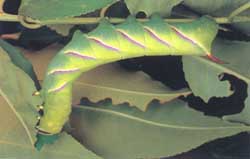 |
Sphinx drupiferarum larvae hide in the day and feed primarily on
cherry, plum, and apple at night.
Larvae have been found on Amelanchier nantuckensis in
Massachusetts and have been reared to pupation in Michigan on
Prunus serotina from eggs readily oviposited by a female.
|
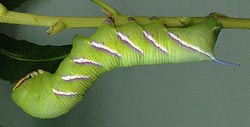 |
Sphinx perelegans
RBCM, the Elegant Sphinx;
A unique feature of this larva is a shield on the first thoracic
segment, which is of the same colour as the body and which forms a
tight-fitting hood over the vertex of the head. This hides a pair of
glossy black spots on top of the head, which are revealed if the
animal is disturbed.
|
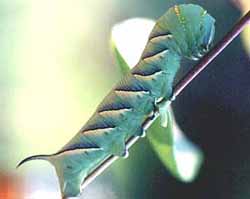 |
Sphinx vashti
RBCM,
the Snowberry Sphinx
Larvae feed on the common snowberry (Symphoricarpos albus)
and on coralberry (S. orbiculatus). Note the two golden lines
of slightly raised bumps, one just behind the head, the other on the thorax.
|
Smerinthini Tribe:
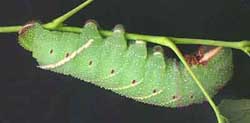 |
Pachysphinx modesta
RBCM,
the Modest Sphinx or Poplar Sphinx
Larvae feed on poplars and cottonwood.
|
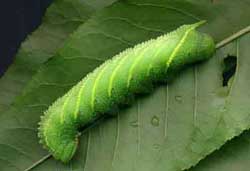 |
Larvae accept willows, birches, and cherries.
I have also found them in the wild on oak in eastern Canada.
The skin of the mature larva has a very grainy appearance.
|
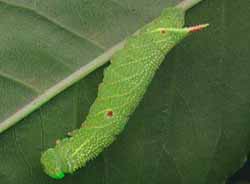 |
Paonias myops
RBCM, the Small-eyed Sphinx
Wild cherry species are the favorites as larval foodplants, but eggs
will also be deposited on birches and other forest trees.
There are varying degrees in the amount of red markings along the sides.
|
 |
Smerinthus cerisyi
RBCM,
Cerisy's Sphinx;
Cerisyi larvae greatly resemble modesta larvae, both being pale
green, with granular skin, pale lateral diagonal lines, faint red
spiracular circles, and very pale longitudinal lines running from the
head to a more pronounced anal diagonal line.
Larvae have green heads bounded dorsally with a pale yellow
inverted "V". Note reddish horn, often blue.
|
Smerinthus cerisyi, east Kootenays, August 1, 2009, Daryll
Smerinthus cerisyi larva, View Royal, August 1, 2010,
Lauren, David, Rick Van Acken.
Smerinthus cerisyi larva, Port Kells/Clayton Heights, Surrey, August 20, 2012,
Lisa Ingvallsen
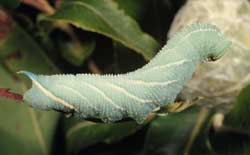 |
Blueish-green larvae feed upon many forest trees including birches and cherries,
but are expecially fond of poplars and willows. Red markings on sides
vary greatly from specimen to specimen. Note blue horn.
|
Macroglossinae subfamily
Dilophonotini Tribe:
 |
Hemaris diffinis
RBCM, the
Snowberry Clearwing or Bumblebee Moth
Larval host plants include Snowberry (Symphoricarpos),
honeysuckle (Lonicera), Coralberry, viburnums, Blue Dogbane
(Apocynum) and dwarf bush honeysuckle (Diervilla lonicera).
Horn is black with a yellow base.
|
 |
Hemaris thysbe
RBCM, the Hummingbird Clearwing
There is also an orangey-pink prepupal form. The lateral line runs
from S1 to the blue horn.
Hemaris thysbe larvae feed on viburnum and related plants.
|
Macroglossini Tribe:
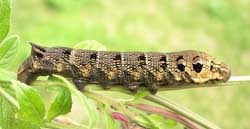 |
Deilephila elpenor
NK/SL/MH, the Large Elephant Hawk Moth
Introduced and established in southern B.C.
Larvae prefer Epilobium and Gallium, but will also eat foliage of other plants.
|
Deilephila elpenor adult, East Vancouver, June 16, 2011, Nayt Keane
Deilephila elpenor adult, Maple Ridge, July 27, 2011, Stephanie Larbalestier
Deilephila elpenor larva, Maple Ridge, August 21, 2012, Marcia Hotvedt
 |
Hyles gallii
RBCM, the Bedstraw Hawk Moth
or Gallium Sphinx.
Larvae, which are smooth, shiny, and predominantly black, grow
extremely rapidly.
They remind me of warm, black licorice strips in that they are shiny,
long and thin, and do not seem to have or exercise much longitudinal
muscle strength.
Larvae come in black and in brown forms and often feed on
Epilobium (fireweed).
|
 |
Hyles lineata
RBCM, the White-lined Sphinx
Larvae are highly varied and feed on a great diversity of plants
including willow weed (Epilobium), four o'clock (Mirabilis),
apple (Malus), evening primrose (Oenothera), elm
(Ulmus), grape (Vitis), tomato (Lycopersicon),
purslane (Portulaca), and Fuschia.
All larvae seem, however, to have the red/black swellings split by
dorso-lateral lines. |
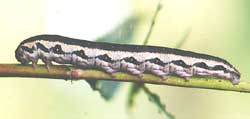 |
Larvae feed on elegant fairyfan (Clarkia unguiculata) in the evening primrose family (Onagraceae).
|
 |
Proserpinus flavofasciata
RBCM, the Yellow-banded Day Sphinx.
The penultimate instar is pale green with a pair of pale,
dorsolateral lines running from head to base of short caudal horn.
The last instar is brown-black with numerous black dots; caudal horn
replaced by black button surrounded by white ring edged with black.
|
|
|


